Patrick DeCorla-Souza, Tolling and Pricing Program Manager, FHWA
Lee Munnich, Humphrey Institute, University of Minnesota
Kenneth Buckeye, Minnesota Department of Transportation
John Doan, SRF Consulting
Center for Innovative Finance Support
Federal Highway Administration
Fifth Part of a Webinar Series on Overcoming the Challenges of Congestion Pricing.
Session 6: Dynamic Ridesharing and Congestion Pricing
Audio:
- Via Computer - No action needed
- Via Telephone - Mute computer speakers, call 1-866-863-9293 passcode 57921953
Presentations by:
- Myron Swisher, SAIC, forrest.m.swisher@saic.com
- Marc Oliphant, Naval Facilities Engineering Command (NAVFAC) Washington, marc.oliphant@navy.mil
- Mark Burris, Texas A&M University, mburris@tamu.edu
- Shamus Misek, Washington State DOT, MisekS@wsdot.wa.go
- Brant Arthur, Climate Protection Campaign, brant@climateprotection.org
Audience Q&A: addressed after each presentation, please type your questions into the chat area on the right side of the screen
Closed captioning was available at: http://www.fedrcc.us//Enter.aspx?EventID=1781245&CustomerID=321
Upcoming Webinars:
Visit https://ops.fhwa.dot.gov/congestionpricing/webinars/index.htm
Recordings and Materials from Previous Webinars:
https://www.fhwa.dot.gov/ipd/tolling_and_pricing/resources/webinars/congestion_pricing_2011.aspx
Upcoming Webinars:
August 25, 2011 - Pay-as-You-Drive Insurance
September 22, 2011 - Economics of Congestion Pricing and Impacts on Business
October 27, 2011 - Integrating Transit with Congestion Pricing and Increasing Congestion Pricing Acceptance
November 17, 2011 - Best Practices in Parking Pricing
December 15, 2011 - Results of the Urban Partnership and Congestion Reduction Demonstration Programs
Part 1: What is Dynamic Ridesharing?
Myron Swisher, SAIC
U.S. Department of Transportation
Federal Highway Administration
"20th Century" Ridesharing
- Traditional TDM (1970s & '80s)
- Car Pooling, Ride Share Matching, HOV Lanes
- Static, Permanent, Daily
- Save time AND $
- Car Pool Lines "Slugging" (1990s)
- Unofficial - Respond to demand
- Primarily 3+ HOV
- Flexible use, static locations
Dynamic Ridesharing
- Social Networking and Smart Phone driven
- Fully on demand & real-time
- Pick up any where along route
- Driver utilizes traveler information for real-time decision to car pool
- Rider connects with driver through smart phone and GPS location
Synergy with Roadway Pricing and Other TDM
Monday Morning
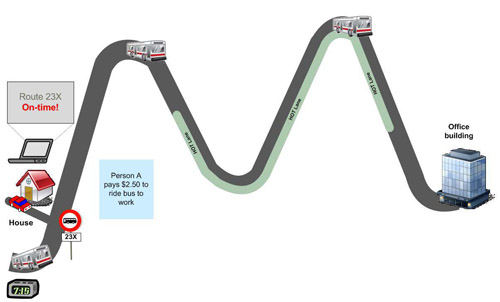
Synergy with Roadway Pricing and Other TDM
Tuesday Morning
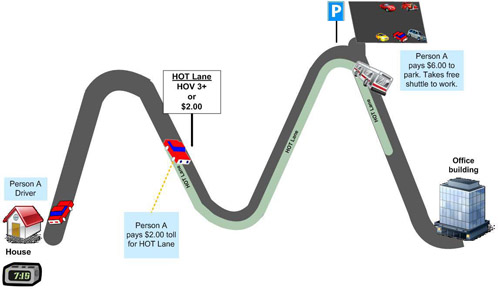
Synergy with Roadway Pricing and Other TDM
Wednesday Morning
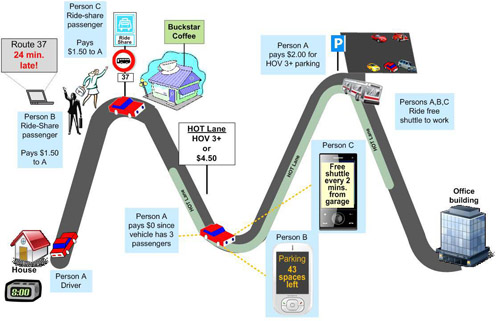
Part 2: The Federal Government's Interest in Dynamic Ridesharing
Marc Oliphant, AICP
Department of the Navy
Dynamic Ridesharing & Congestion Pricing Webinar
Why is Dynamic Ridesharing Important to the Government?
- Reduces vehicle-miles traveled, leading to:
- Congestion mitigation
- Carbon and air-pollutant emissions cuts
- New infrastructure expenditure reductions
- Potential to provide socially-necessary transportation.
- Senior citizens, dial-a-ride, college students
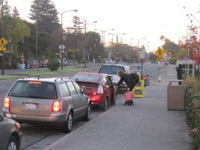
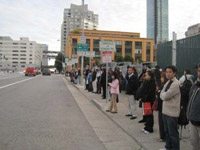
Why is Dynamic Ridesharing Important to the Government?
- More efficient use of current infrastructure
- Numerous possibilities for an increasingly connected world
- Person throughput focus vs. vehicle throughput
- Filling empty seats that are already making the trips
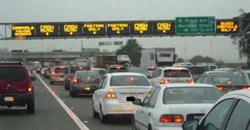
Photo Credit: Mark Burris
Government Role
- Federal Congestion Mitigation and Air Quality Improvement (CMAQ) Program funding.
- Provided to State DOTs & MPOs
- State and local funding
- Federal Gov often matches
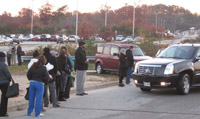
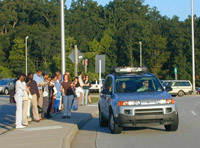
Government Role
- Federal discretionary grant funding
- Value Pricing Pilot Program (VPPP)
- 2010: Santa Barbara, CA pilot program funded
- 2011: 4 dynamic ridesharing applications (of 30 total)
 Exploratory Advanced Research (EAR)
Exploratory Advanced Research (EAR)
- Scan tour of DC, Houston, and San Fran casual carpool lines
- Focus Groups (upcoming)
- Small Business Innovation Research (SBIR)
- 2011 DOT SBIR Phase I Project Funded & Underway
- Specifically Investigating:
- Automated HOV Reporting Solutions
- Hardware (seat sensors)
- Software Solution (ridematching software interface)
- Syncing Ridematching Software w/ In-vehicle Computer
Logo Credit: Mark Burris
Part 3: Casual Carpooling in Houston
Mark Burris
Texas A & M University
Mburris@tamu.edu
Houston, TX
- Slugging occurs at three locations
- Kingsland and Addicks Park & Ride lots on I-10
- NW Station Park & Ride lot on US 290
- Occurs mostly between 6:00 AM and 9:00 AM, concentrated during HOV3+ periods
- Changes with HOV occupancy requirements
- Mainly use transit for return trips, a small percentage slug back from Louisiana Street (downtown)
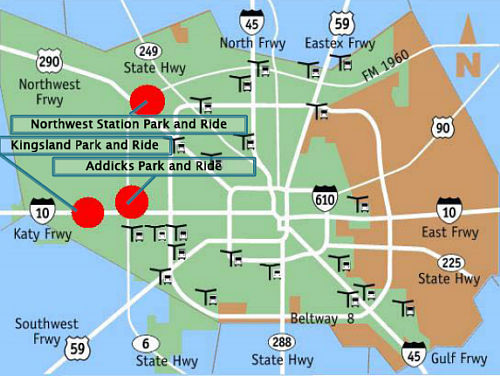
Northwest Freeway (US 290)
- HOV Lane:
- SOVs never allowed, Buses always free
- from 5 am to 6:45 am
- From 6:45 am to 8:00 am
- HOV 2 pay $2 toll through QuickRide program
- HOV 3+ free
- From 8:00 am to 11 am and 2 pm to 7 pm:
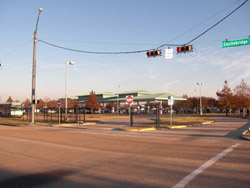
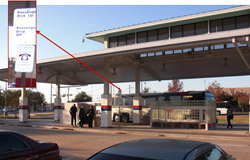
Katy Freeway (I 10)
- 1 HOV Lane (pre-2009):
- SOVs never allowed, Buses always free
- From 6:45 am to 8:00 am and 4 pm to 5 pm
- HOV 2 pay $2 toll through QuickRide program
- HOV 3+ free
- Other times:
- 4 Managed Lanes (2009 - present)
- SOVs pay a toll all times, HOVs pay in off-peak
- Buses always free
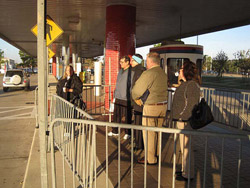
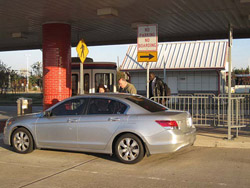
Houston - The Trip Back
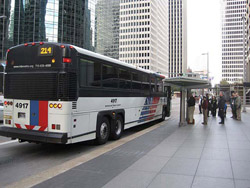
Characteristics (2003 Survey)
| |
Travelers
(n=1032) |
Traditional HOV on the HOV lane
(n=331) |
Casual
Carpool Passengers 4+times/wk
(n=149) |
Transit Riders
(n=290) |
| Trip Purpose |
|
| Commute AB |
85.0% |
79.8% |
96.0% |
88.9% |
| Work (non-commute) |
9.0% |
5.8% |
4.0% |
7.3% |
| Other |
6.0% |
14.4% |
0.0% |
3.8% |
| Trips per Week |
9.85 |
9.91 |
9.67 |
9.20 |
| Sex A |
|
| Male |
60.9% |
49.7% |
50.7% |
45.8% |
| Female |
39.1% |
50.3% |
49.3% |
54.2% |
| Number of Vehicles A |
2.42 |
2.39 |
2.22 |
2.19 |
A Significant (p ≤ 0.05) difference when comparing all four modes
B Significant (p ≤ 0.05) difference when comparing casual carpooling and transit
Casual Carpool Passenger Characteristics
(n = 208, all slugs)
| Familiarity With Current Carpool Companions |
|
| Never traveled with before |
65.3% |
| Traveled with once or twice before |
28.1% |
| Travel with frequently |
6.6% |
| Frequency of Casual Carpool Use |
|
| Everyday |
52.0% |
| 3 to 4 days per week |
24.0% |
| 1 to 2 days per week |
19.9% |
| Less than once per week |
4.1% |
| First time |
0.0% |
| Mode Used for Evening Return Trip |
|
| Casual carpool |
12.8% |
| Bus |
66.3% |
| regular carpool with family or friends |
5.1% |
| Drive alone |
0.0% |
| Other |
15.8% |
Slug Counts
| Date |
Kingsland * |
Addicks * |
Northwest Station |
| June 2009 * |
70
Ended just before 9, mostly 2 slugs |
30
Ended around 8:30, mix of 1 and 2 slugs. |
203
Ended just after 9, 2 slugs during QuickRide, 1 otherwise |
| October 2008 *A |
122
Ended just before 9, mostly 2 slugs |
76
Ended around 8:45, mostly 1 slug. |
208
Ended just after 9, 2 slugs during QuickRide, 1 otherwise |
| November 2003 |
161 |
203 |
214 |
| June 2003 |
130 |
219 |
135 |
A Katy single HOV lane still (partially) operational but under transition to Managed Lanes
* Katy Managed Lanes (HOV 2+ Free) began November 2008
* Katy Managed Lanes Allowed SOVs for a toll beginning April 2009
Part 4: Washington State Department of Transportation - SR 520 Carpool Pilot Project
Shamus Misek
WSDOT Rideshare Program Manager
Paula Hammond
Secretary of Transportation
Brian Lagberberg
Director -Public Transportation Division
FHWA
Congestion Pricing Webinar July 28, 2011
Public Transportation Related Experience
Rideshare Program Manager, WSDOT (2009-Present)
Manager, Research Transportation Programs - University of Illinois/Urban Transportation Center, Chicago (2001-2008)
Department Manager, Vanpool Services - Pace Arlington Heights, IL (1990-2001)
ADA Compliance Manager - Pace, Arlington Heights, IL (1989-1991)
Special Projects Manager - Pace, Arlington Heights, IL (1985-1989)
Senior Project Manager, Paratransit Services - Regional Transportation Authority (RTA) Chicago, IL (1980-1985)
Overview of WSDOT Pilot Project
- Identified in 2009 state transportation budget ($400K)
- Develop a pilot carpool project -SR 520 corridor
- Enables carpooling without pre-arrangement
- Allows for transfer of rider credits between participants
- Membership system
- Pre-screening to ensure participant safety
Project Purpose and Objective
- Design and Implement a limited scale carpool pilot
- On an accelerated schedule
- Examine its effectiveness in reducing vehicle trips and vehicle miles traveled (VMT)
- Evaluate the costs and benefits
- Target audience
- Commuters who drive alone on SR 520
WSDOT Pilot Project Goals
- Design project that is achievable within time period
- Test the viability and feasibility of this type of project with and without tolling on the SR 520 corridor
- Ensure the safety and security of project participants
- Reduce vehicle trips and VMT
- Report project results and lessons learned
- Recommend future implementation possibilities
Pilot Project Challenges
- Satisfying legislative intent and ensuring:
- Pilot project participants' safety
- Minimizing the state's potential exposure to liability and risk
- Recruiting a significant pool of participants
- Approving 250 drivers and 750 riders
Pilot Technology Overview
- Mobile phone application employed for drivers
- Drivers use GPS-enabled mobile smart phones
- Verification of each ride
- Capture trip - travel time, location and distance
- Micro-payment capabilities
- Between driver and rider
- Based on miles traveled
- Technology provides
- Verifiable and auditable trip trail
- SOV trip reductions
- Pick-up/ drop off locations identified
- Security features built into vendor application
- Auto generated PIN# rider shows driver
- Description of driver's vehicle
- Screen icon shows individual has passed pre-screening requirements
- Trip rating system
- Driver and rider rating system
SR 520 Overview
- SR 520 bridge tolling/Good to Go! marketing
- Smarter highways traffic management technology
- RideshareOnline.com upgrades
- King County Metro transit enhancements
- Communications & public outreach
- Vanpool promotion
- Employer-based commute trip reduction programs
Vendor / Evaluation and Advisory Committee Concerns
Required pre-screening criteria requirements
- Limit the potential pool of driver candidates
- Difficult to attract 250 drivers
- Deter some individuals from applying to participate
- Turn away some individuals
Pre-Screening Criteria / Requirements
- Driver candidates
- DOL driving record abstract review
- ($300 K) per accident minimum liability insurance coverage
- Provide social security number (riders too)
- Criminal background check (riders too)
- Certify that to the best of their knowledge - followed prescribed vehicle manufacturer required maintenance schedule
Key Timeline & Activities
- Oct 2010 - Contract executed
- Nov 2010 - Vendor initiates beta testing and project benchmark stage
- Dec 2010 - Benchmark stage completed
- Jan 2011 - Formal launch and media campaign
- Feb 2011 - Process to convert initial sign-ups to approved pilot users commences
- March 2011 - Corridor strategy development begins
- April 2011 - Expanded recruitment and driver 1.0 app on Windows Phone 7
- May 2011
- Evaluation activities
- Exit surveys
- Focus groups
- Project wind-down / close-out
- Transition from WSDOT funded to AVEGO funded pilot
Registrants and Participant Approval Process
- 962 individuals signed-up to participate
- 842 regular SR 520 commuters
- 35 % Microsoft employees
- 279 individuals provided their SSN
- Fully approved
What Potential Participants Said
- Positive
- Opportunity to save time (58%)
- Opportunity to save $$ (42%)
- Instead of driving solo
- Impending tolls
- Concept of real-time ridesharing was favorable
- Negative
- Did not want to provide SS # (49%) especially to a 3rd party
Potential Benefits / Opportunities
- Additional tool in the TDM toolbox
- Additional option for individuals to use in conjunction with or as a complement to transit
- Alternative to driving solo to park-n-rides/rail stations
- Can lead to more efficient use of current infrastructure
Government's Role Moving Forward
- Financial investment (?)
- Obstacles
- Publicize/market it along with other commute trip option tools
- Bring vendors to table with already established partners
Contact Info
Shamus Misek
Rideshare Program Manager
WSDOT
Public Transportation Division
P. O. Box 47387
Olympia, WA 98504-7387
miseks@wsdot.wa.gov
(360) 705-7346
Part 5: Real-Time Ridesharing: Sonoma | Marin | Contra Costa | 2011-12
Brant Arthur
brant@climateprotection.org


Our Team:
- Metropolitan Transportation Commission
- Sonoma County Transportation Authority
- Contra Costa Transportation Authority
- Transportation Authority of Marin
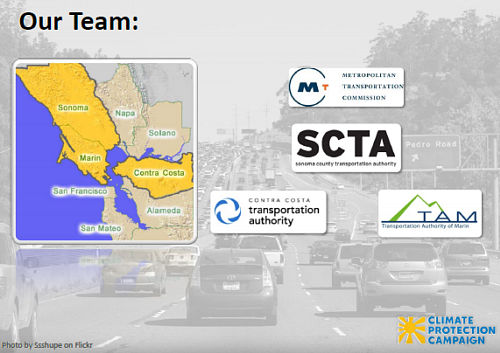
Photo by Ssshupeon Flickr
Our Approach:
As the Climate Protection Campaign:
- Pricing is one of the most effective methods for change
- Must line up policy, regulations and incentives]
In this pilot:
- Seat pricing instead of lane pricing
- Affinity groups key to a successful launch
Timeline:
July/Aug. '11 - Software RFP released
Sept./Oct. '11 - Sign contract with software vendor
Nov. '11 - Initial testing
Jan./Feb. '12 - Launch pilot
Feb.'13 - Transition
Survey:

Age: 78.5% of 18-24 year old willing to try; 39.5% of 56 and older
Income: 75% of participants earning up to $25k; 33% of those earning $100K more
Distance: 79% of those commuting over an hour vs. 53% with commutes under 15 minutes
Focus Groups:
Observations:
- Price: Wide variability on what a "fair" price would be, but apparent consensus on avoiding negotiating
- Technology: Commuters had no problem with smartphones, while students had concerns about costs and lifestyle changes
- Schedule: Commuters more likely to have family concerns while students have less predictable schedules
Software RFP:
Important Features:
- Focus on iterative design and outreach
- Ability for the system to charge riders
- Include transit matches
Dates:
- Submit Proposals: August 23, 2011
- Interview Dates: September 13 - 14, 2011
- More info: www.sctainfo.org/rfp.htm
Questions?
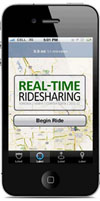
http://wegorideshare.com/sonoma/
brant@climateprotection.org








 Exploratory Advanced Research (EAR)
Exploratory Advanced Research (EAR)










